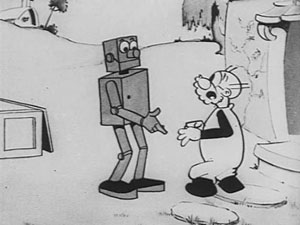 Who hasn’t been fascinated by robots? The concept of a contraption of gears and wires springing into lifelike action is as spellbinding as watching cartoon drawings “coming to life” on a screen. Is it any wonder that animators took a shine to the gleaming, plated “monsters” from fairly early days, and returned to the subject again and again over many generations?
Who hasn’t been fascinated by robots? The concept of a contraption of gears and wires springing into lifelike action is as spellbinding as watching cartoon drawings “coming to life” on a screen. Is it any wonder that animators took a shine to the gleaming, plated “monsters” from fairly early days, and returned to the subject again and again over many generations?
Wikipedia provides a comprehensive article on origins of the term “Robot” in Slavic language and in a play of 1920, “R.U.R.” Some of the first uses of the automaton, by no strange coincidence, appear to begin in the 1920’s, in various exotic forms quite unique to the animated genre. It appears that the fully humanized robot would wait to make its entrance into cartoons in the sound era of the 1930’s – perhaps in the wake of such notable live-action works as Fritz Lang’s “Metropolis” (1927). Another influence from literature and subsequently live action also seems to come into play in animation’s dealing with the subject – the legend of creation turning upon its maker, growing from Mary Shelley’s “Frankenstein”. (Although Frankenstein’s monster was built of formerly living tissue rather than cold steel, animators didn’t seem to make much of a distinction in this regard – witness, for example, Chuck Jones’s vivid drawings of the monster in Sniffles and the Bookworm (Warner, Merrie Melodies, 12/2/39), which for all intents and purposes sculpt and move the monster as if he were a robot!).
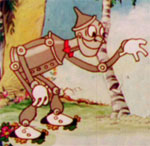 And there was of course a purely American influence that was also of tremendous and ever-growing popularity dating from much earlier than the 1920’s – L. Frank Baum’s “Oz” series, which, while not using the term “robot”, introduced a tin woodsman in “The Wonderful Wizard of Oz” (1900) and another mechanical clockwork man (“Tik Tok”) in “Ozma of Oz” (1907). All these influences seem to have congealed into an amalgam for the indutry that would heavily shape the image of robots for the 1930’s – long before images of the space age would reframe concepts into more highly technical and streamlined forms.
And there was of course a purely American influence that was also of tremendous and ever-growing popularity dating from much earlier than the 1920’s – L. Frank Baum’s “Oz” series, which, while not using the term “robot”, introduced a tin woodsman in “The Wonderful Wizard of Oz” (1900) and another mechanical clockwork man (“Tik Tok”) in “Ozma of Oz” (1907). All these influences seem to have congealed into an amalgam for the indutry that would heavily shape the image of robots for the 1930’s – long before images of the space age would reframe concepts into more highly technical and streamlined forms.
So where did animation first decide to find its ideal places for mechanization? From where else? – The old traditional barnyard. A standard and favorite turf for early animators was to fill a farm with scads of funny animals. So why not adapt it to include funny animal robots too?
Paul Terry appears to have been among the first to make this move. His Aesop’s Fables productions were still in their early years when an episode appears entitled The Mechanical Horse (1922). This is again one of those hundreds of silent cartoons for which there is no data or source prints available for research on the internet, and one wonders if it survives in private hands in some Commonwealth “Farmer Gray” goat-glanded sound edition or otherwise. But the legacy of this film seems to be plain to see if you are at all a follower of early Terry animation. There is an unwritten law throughout the 1920’s, and even into the Van Buren and Terrytoons days of early sound, that 99 times out of a hundred if a horse is depicted in a Terry production, he will have a body built of an old oil drum, and legs that look like they are assembled out of old tin cans with hinge joints – not to mention a fully removable head so that various things or critters can be stored inside. It would appear that the Terry animators had great difficulty in drawing a realistic horse – such that, following this 1922 production, Paul just figured the simplified robot model suited his animators better – so just stick with it. It probably got a few laughs from early audiences, which Paul must have felt was also a plus. Continued examples of this design can be seen as late as Hungarian Goulash (Terrytoons, 6/29/30), and in Van Buren’s Happy Polo (Aesop’s Fables, 5/14/32), the latter a reissue with sound of a silent Terry, The Polo Match (6/2/29), featuring entire teams of the mechanical quadrupeds, fueled by removing their heads and pouring in gasoline – also fully rebuildable after they break apart in pieces in the middle of play!
So if it worked for horses – what about cows? A young animator named Walter enjoyed his first successes in rivalry of Terry during the 1920’s, first with “Alice Comedies” featuring a live-action girl in an animated world, then with his first successful all-animated series, Oswald the Lucky Rabbit for Universal. It is here that Mr. Disney fabricated his first tin “creature”, in Oswald’s The Mechanical Cow (10/3/27). This model is a bit unusual for a robot – in that it not only requires sleep like a living creature (in a bed yet instead of a stall), but is almost impossible to wake up in the morning. After several minutes of effort just to get the critter downstairs, Oswald succeeds in sending it down a chute, where two pairs of roller skates wait at the ready and attach to its feet, making it highly mobile. Oswald and cow roam the countryside, attempting to sell a morning supply of milk. A passing mother hippo and her child in a carriage are their first customers. Oswald opens a hatch in the cow’s body and pulls out a clear tank such as used on old-fashioned service-station pumps – then cranks the cow’s tail to fill it up with an even gallon. He then produces an auto dip-stick and measures the baby’s needs by sticking it down his throat. Reading nearly empty, Oswald provides the child with a hose, through which he sucks up the gallon in a matter of seconds. Oswald’s girlfriend (a rabbit this time – not the cat Ortensia), is his next customer. Oswald flirts liberally with the girl until the cow gets too nosy, and Oswald has to scold her and send her for a “time out” into the opposite corner of the pasture.
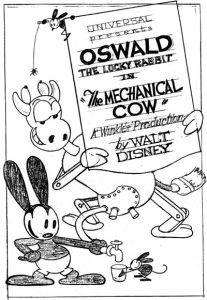 For no apparent reason and without any provocation, a sinister sedan pulls up, and a hat emerges in mid-air – from which drops an evil cat villain who abducts Oswald’s girl and takes off with her in the car. (Possibly, some intertitle was excised from the film’s present version which might have supplied the motivation.) It turns out the cat also has a small gang of henchmen inside the car with him, who all give Ozzie’s girl a run for her money as she tries desperately to escape their clutches.
For no apparent reason and without any provocation, a sinister sedan pulls up, and a hat emerges in mid-air – from which drops an evil cat villain who abducts Oswald’s girl and takes off with her in the car. (Possibly, some intertitle was excised from the film’s present version which might have supplied the motivation.) It turns out the cat also has a small gang of henchmen inside the car with him, who all give Ozzie’s girl a run for her money as she tries desperately to escape their clutches.
It’s Oswald to the rescue, the cow coming to his aid as a trusty steed. They give chase, amidst a hail of bullets from the cat gang. Oswald unscrews the cow’s neck from its body (while the cow’s head miraculously maintains its position and running speed by staying put in mid-air), and curves the hollow neck into a “U” – funneling bullets into one end to be shot back at the baddies out the other. In a scene that would probably be remembered by Paul Terry for later repeated use well into the 40’s for whenever he needed villains to have an “instant arsenal”, the roof of the car peels back to let out a giant cannon barrel five times too long to fit in the car. It fires, then goes entirely limp, and has to be dragged back into the car. The cow swallows the cannonball, and explodes. As the smoke clears, only its legs are seen running in the same place as before the explosion. But the cow’s head, tail, and finally its body and Oswald fall back into place from the sky and the chase proceeds. Oswald pulls the cow’s tail like a lever – and a telepone extender is revealed at the base of the cow’s head, which is extended so the cow’s head can stretch to reach the car and bite a grip on its roof, while Oswald climbs over the extended neck and boards the villain’s vehicle. He grabs his girlfriend, and they both return to the cow’s “chassis” by standing on the cow’s head as the neck retracts.
Now for a getaway. Easy, as Oswald just reverses the position of the cow’s head and tail – and suddenly she’s running in the opposite direction. The villains, though, are just as resourceful – their car simply turns inside out, and suddenly they’re in reverse direction too. Our silk-hatted abductor leaps off the car’s hood and tries to catch up with the cow. He grabs at her tail, but she swishes it away. He grabs her udder – and gets a milk bath. The cow comes to a cliff and stops cold – but Ozzie and his girlfriend sail off of her back and over the cliff. Ozzie catches a branch sticking out of the cliff face, and his girlfriend catches hold of his trousers – pulling Oswald’s pants down three times in succession. The villains’ car approaches. Rather than run, the cow merely sets herself at an incline, so the car runs up her tail and over her back like a ramp, and over the cliff. Below wait a school of sharks in the water – one for every bad guy – and each villain is swallowed whole. The wave from the villains’ impact rises to where Oswald and girlfriend cling to the branch – and they ride on the crest of the wave back to the cliff top, to be reunited with the cow. The cow warps her tail to provide a staircase for the pair to remount. Before taking off, Oswald reveals a last custom feature of the cow’s design – a rear hatch, that opens to a rumble seat for his girlfriend, as the happy trio ride off to horizon for the iris out.
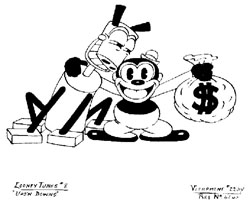 Ups ‘n Downs (Warner, Hugh Harman-Rudolf Ising, Bosko (Looney Tunes), 4/4/31 – “Drawn by” Rollin Hamilton/Paul Smith) – Hot dog vendor Bosko is acting very clandestine about the secret contents of a locked stall at a racetrack. Perhaps he has good reason to be secretive – as it appears he has stolen right out from under Paul Terry’s nose one of Terry’s trademark robot horses. Unlike some of Terry’s, this one runs on a spring motor rather than gasoline – with a mainspring prone to malfunction. First, Bosko winds up the horse’s tail – and the horse’s head spins around endlessly. When Bosko holds the head in place, the spring bursts out of a compartment in the chassis, and has to be recompressed inside. The tail not only acts as a winder, but as a gearshift lever. However, at the call to the post, Bosko accidentally shifts into reverse, crashing the pony into a wall and into a thousand nuts and bolts. Bosko is hardly upset by this setback, as he produces a cocktail shaker, inserts all the components, shakes well, and pours out the reassembled pony. He begins to catch up to the other racers. The favorite’s jockey, a moustached bully, spits contemptibly at the robot, causing it to trip. Suddenly, Bosko is carrying the horse on his own back. Next, the villain throws a hand grenade. In a direct lift from “The Mechanical Cow”, the horse’s running legs remain after the explosion, while parts falling back to Earth reassemble themselves. In a further direct steal from “Mechanical Cow”, Bosko extends the horse’s neck with a telephone extender and wins by a nose – only to have the mainspring pop out again in the winner’s circle. (Of curious note is a color-retraced version for television performed without Warner’s consent in approx. 1960, retitled “Off to the Races”. You can tell it’s in trouble from the start, as the print they’re tracing from is chock full of splices, truncating action and cutting into several lines of what little dialog there is in the film. To make matters worse, the film breaks abruptly upon the throwing of the hand grenade – so the animators improvised about four shots to fake their own ending! – forgetting in the process that the horse was a robot, such that in the final scenes, he’s drawn as a real horse! Go figure.)
Ups ‘n Downs (Warner, Hugh Harman-Rudolf Ising, Bosko (Looney Tunes), 4/4/31 – “Drawn by” Rollin Hamilton/Paul Smith) – Hot dog vendor Bosko is acting very clandestine about the secret contents of a locked stall at a racetrack. Perhaps he has good reason to be secretive – as it appears he has stolen right out from under Paul Terry’s nose one of Terry’s trademark robot horses. Unlike some of Terry’s, this one runs on a spring motor rather than gasoline – with a mainspring prone to malfunction. First, Bosko winds up the horse’s tail – and the horse’s head spins around endlessly. When Bosko holds the head in place, the spring bursts out of a compartment in the chassis, and has to be recompressed inside. The tail not only acts as a winder, but as a gearshift lever. However, at the call to the post, Bosko accidentally shifts into reverse, crashing the pony into a wall and into a thousand nuts and bolts. Bosko is hardly upset by this setback, as he produces a cocktail shaker, inserts all the components, shakes well, and pours out the reassembled pony. He begins to catch up to the other racers. The favorite’s jockey, a moustached bully, spits contemptibly at the robot, causing it to trip. Suddenly, Bosko is carrying the horse on his own back. Next, the villain throws a hand grenade. In a direct lift from “The Mechanical Cow”, the horse’s running legs remain after the explosion, while parts falling back to Earth reassemble themselves. In a further direct steal from “Mechanical Cow”, Bosko extends the horse’s neck with a telephone extender and wins by a nose – only to have the mainspring pop out again in the winner’s circle. (Of curious note is a color-retraced version for television performed without Warner’s consent in approx. 1960, retitled “Off to the Races”. You can tell it’s in trouble from the start, as the print they’re tracing from is chock full of splices, truncating action and cutting into several lines of what little dialog there is in the film. To make matters worse, the film breaks abruptly upon the throwing of the hand grenade – so the animators improvised about four shots to fake their own ending! – forgetting in the process that the horse was a robot, such that in the final scenes, he’s drawn as a real horse! Go figure.)
The 30’s weren’t through with animal robots yet. Virtually every gag involving the robot horse from Ups ‘n Downs gets retreaded again by Harman-Ising at their new studio (MGM) for the first 3-strip Technicolor Happy Harmony, The Old Plantation (9/21/35). No, surprisingly there are no retracings of old drawings. But all the setups are well remembered and recreated. Set amongst a community of toys (mostly rag dolls and a few mechanical figures), Colonel Julep seeks to avoid foreclosure on his toy Southern plantation by Simon Degree by entering his prize pony, Black Beauty, in a big race (set at a toy track where the racing field is actually an embroidered doily). Black Beauty is of course, again, a spring wind-up mechanical horse. He repeats the exact same routine of having his head spin round when his tail-key is wound up, then popping his mainspring out his back. Simon notes the horse’s power source, and when no one is looking steals the mainspring innards and dumps them in water.
 Beauty is left at the post without power. Fortunately, the race for some reason includes several laps around the track – just to leave enough time for a solution to present itself. Beauty’s jockey finds same in the form of skyrockets, which he stuffs into Beauty’s empty torso and ignites. Of course Beauty gains several laps on the others. His power, however, runs out just short of finishing the race, and, as with Bosko, the jockey has to carry Beauty on his own back. Finally, at the finish line, Beauty’s head pops out in a long extension – not by a telephone extender like Bosko’s, but on the end of a popped spring (I thought Simon stole all his spring works!). Beauty wins, and the plantation is saved. As Ups ‘n Downs wasn’t a very memorable cartoon, 30’s audiences, with memories four years dimmed, probably were too dazzled by the Technicolor to even notice in 1935 that Harman and Ising were just covering old ground. Now, with the convenience of Internet hindsight, their 10 minute color extravaganza seems massively diminished, from knowing in advance what’s going to happen before it even gets there.
Beauty is left at the post without power. Fortunately, the race for some reason includes several laps around the track – just to leave enough time for a solution to present itself. Beauty’s jockey finds same in the form of skyrockets, which he stuffs into Beauty’s empty torso and ignites. Of course Beauty gains several laps on the others. His power, however, runs out just short of finishing the race, and, as with Bosko, the jockey has to carry Beauty on his own back. Finally, at the finish line, Beauty’s head pops out in a long extension – not by a telephone extender like Bosko’s, but on the end of a popped spring (I thought Simon stole all his spring works!). Beauty wins, and the plantation is saved. As Ups ‘n Downs wasn’t a very memorable cartoon, 30’s audiences, with memories four years dimmed, probably were too dazzled by the Technicolor to even notice in 1935 that Harman and Ising were just covering old ground. Now, with the convenience of Internet hindsight, their 10 minute color extravaganza seems massively diminished, from knowing in advance what’s going to happen before it even gets there.
Terrytoons continues to make a few late entries in the animal robot competition, beginning with a borrow not only of concept, but of title, in the Farmer Alfalfa installment, The Mechanical Cow (Terrytoons/Educational, 6/25/37 – Jack Zander, dir.). However, unlike many Terry “borrows”, this one goes well beyond its Oswald predecessor, with some creative ideas, surprisingly excellent animation, and zippy pacing. Farmer Al enters his barn in the morning to milk his cow. His hat falls over his eyes as he enters the stall, but he sits on his stool anyway and reaches for udders – that are “udderly” missing , along with the cow itself. Feeling nothing, Al raises his hat, and looks everywhere for the missing bovine. He finds her outside, wearing sandwich-board protest signs announcing a 30’s labor craze – a ”sit-down” strike. Alfalfa, pleads, then commands, but all the cow will do is moo a loud “No”. The blast of this word knocks Alfalfa back into the barn, where a framed chart depicting a cow’s beef cuts falls on Alfalfa’s head. Seeing the cow’s make-up, Alfalfa gets an idea. Taking measurements from the chart, and assembling a collection of various metal odds and ends (including stove pipes, a boiler, an alarm clock, and a mailbox for a head), Alfalfa constructs a mechanical cow. Feeding it hay, Alfalfa is overjoyed as the contraption starts ejecting milk bottles from its torso.
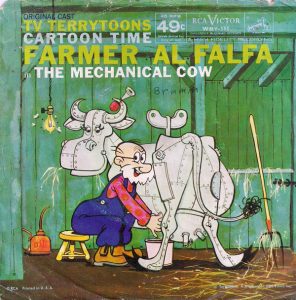 He pokes his head out the barn door, and makes jeering faces at the real cow. The real one gets curious, and while Alfalfa carries a load of milk bottles to his front porch, the real cow takes a peek in the barn. Seeing more milk bottles popping out of the mechanical one, she tries to hold the hatches of the robot shut to keep them in. Seeking more hay, the mechanical one accidently eats instead the real cow’s strike signs. The effect – the robot engages in a sit-down strike itself, and when Alfalfa returns, he gets a paper note to such effect from inside the cow instead of more milk bottles. Angry, Alfalfa kicks the robot to get it to work, but forgets it’s metal and merely stubs his big toe. He hops backwards in pain, and falls upon a board over a sawhorse. On the other end of the board is Alfalfa’s welding torch which he used during construction – still on. (Al, you ought to know better. Didn’t you ever hear of Mrs. O’Leary?) The torch gets flipped into the air – and lands inside the robot’s open back hatch. Flames arise inside.
He pokes his head out the barn door, and makes jeering faces at the real cow. The real one gets curious, and while Alfalfa carries a load of milk bottles to his front porch, the real cow takes a peek in the barn. Seeing more milk bottles popping out of the mechanical one, she tries to hold the hatches of the robot shut to keep them in. Seeking more hay, the mechanical one accidently eats instead the real cow’s strike signs. The effect – the robot engages in a sit-down strike itself, and when Alfalfa returns, he gets a paper note to such effect from inside the cow instead of more milk bottles. Angry, Alfalfa kicks the robot to get it to work, but forgets it’s metal and merely stubs his big toe. He hops backwards in pain, and falls upon a board over a sawhorse. On the other end of the board is Alfalfa’s welding torch which he used during construction – still on. (Al, you ought to know better. Didn’t you ever hear of Mrs. O’Leary?) The torch gets flipped into the air – and lands inside the robot’s open back hatch. Flames arise inside.
Alfalfa runs for water, but accidently grabs a second bucket marked “gasoline”. Boom! The ignited fuel not only causes the robot to rise, but to charge both Alfalfa and the real cow in a wild chase. (There is a short cut in the current TV prints where some gag appears to be removed here for time.) When we rejoin the action, Alfalfa is attempting to lasso the robot as it makes laps around the barn. The other end of the rope is attached to a panel of the barn itself. The robot is roped, but not only pulls the panel off the barn, but gets fouled in Alfalfa’s plow. The robot takes off, with Alfalfa in tow atop the barn panel like a water-skier, plowing up every acre of Alfalfa’s farm in neat furrows. The real cow also gets caught atop the plow, and the three of them continue at full steam down the highway. Behind the county road, we see a large locomotive approach on a parallel train track. The train and the robot are in a neck and neck race, toward the inevitable junction. As Alfalfa shrieks in dread of what is about to happen, the cow crosses the tracks at the precise instant the train crosses the road. Blam! Alfalfa and the cow, though spun around like tops, wind up on either side of the passing train. But it appears, for the moment, that the robot is no more. Alfalfa and the real cow are so happy to be alive, they embrace, dance, and all is forgiven. But not so fast. From the sky fall various parts of the cow, mixed with various parts of the train – assembling piece by piece a wheeled, cowcatchered, “cow-comotive”, which builds up steam as Alfalfa and the real cow retreat step by step, then take off at full run down the track as the cow-train pursues them through a tunnel, over a trestle, and off into the horizon for the iris out. A clever and highly entertaining cartoon, which was singled out during the 1950’s as the only Farmer Alfalfa story to be loosely adapted to records for an RCA single and the album, “TV Terrytoons Cartoon Time” (pictured above).
Warner Brothers, and particularly Bob Clampett, also noticed this renewed interest in robot cows. Within less than a year, Clampett would reveal his own model – the “Creamlined cow of 1938″, in Porky’s Poppa (Warner, Looney Tunes, Porky Pig, 1/15/38). This film has already been thoroughly reviewed in my previous article on this website, Toons Abhor a Vacuum, Part 1, complete with embed of the film itself, to which the reader is directed.
And Terry would return with one more go-around for its mechanical horses. The Village Blacksmith (Terrytoons, Fox, 12/2/38 – Mannie Davis, dir.), is considered something of a “lost” film, as it was never included in the CBS TV package (although negative elements should exist in present holdings at UCLA Film Archive). However, many of the black-and-white titles from the late 30’s and early 40’s chosen to not be included for TV exhibition were chosen for a reason. CBS, then telecasting in black and white, realized that several early titles had been redrawn or reworked into Technicolor versions by Terry in later years. As either version would be presented in black and white, there would be no meaningful way of telling one version apart from another if both an original and a remake were included in the package (or worse yet, were telecast in close proximity to one another). So CBS opted in general to use the possibly more advanced color versions, and hold back their black-and-white counterparts (with rare exceptions, when there were enough discernable plot differences in a remake to allow for some distinction between versions, as in the comparison between “Pink Elephants” and “Mrs. Jones Rest Farm” discussed in my “Vacuum” article discussed above.) “Blacksmith” is believed to be one of the films with a direct color counterpart, in the form of Time Gallops On (4/1/52 – Mannie Davis, dir.), which, even in color, reveals a coarser outline and earlier style to its drawings than contemporary 50’s titles, giving away its probable earlier origins. The color version is thus reviewed here as presumably identical or nearly identical to its 30’s “brother”.
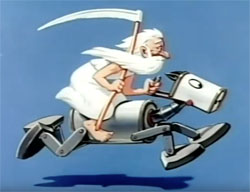 Focus of the story is Joe, the village blacksmith. Happy in his work, he labors under the belief that the horse is here to stay. But the march of progress (depicted by periodic scenes of Father Time, parodying the “Time Marches On” slogan of “The March of Time” radio news show) is relentless. First comes a primitive horseless carriage (prompting Joe’s laughter and remark, “Get a horse!”). Newer models arrive and, as the narrator notes, the horse begins “fading out” – depicted by five horses literally camera-dissolving out of the scene in Joe’s shop. A new auto develops a flat tire, and Joe volunteers to “fix it” – virtually wrecking the thing, and substituting a horseshoe for the busted wheel. But his revenge is short lived. Gas stations spring up around him to service even newer models, and Joe tries in vain to compete by installing his own hydraulic auto-lift to lift his only customer’s horse while he shoes it. Finally, the city is full of cars, and Joe waits hopelessly in his shop while a spider spins a web between Joe’s nose and his anvil. The narrator encourages Joe not to give up. An idea is born – to defeat the “fad” of the automobile by constructing a superhorse – another four-legged robot.
Focus of the story is Joe, the village blacksmith. Happy in his work, he labors under the belief that the horse is here to stay. But the march of progress (depicted by periodic scenes of Father Time, parodying the “Time Marches On” slogan of “The March of Time” radio news show) is relentless. First comes a primitive horseless carriage (prompting Joe’s laughter and remark, “Get a horse!”). Newer models arrive and, as the narrator notes, the horse begins “fading out” – depicted by five horses literally camera-dissolving out of the scene in Joe’s shop. A new auto develops a flat tire, and Joe volunteers to “fix it” – virtually wrecking the thing, and substituting a horseshoe for the busted wheel. But his revenge is short lived. Gas stations spring up around him to service even newer models, and Joe tries in vain to compete by installing his own hydraulic auto-lift to lift his only customer’s horse while he shoes it. Finally, the city is full of cars, and Joe waits hopelessly in his shop while a spider spins a web between Joe’s nose and his anvil. The narrator encourages Joe not to give up. An idea is born – to defeat the “fad” of the automobile by constructing a superhorse – another four-legged robot.
Joe works night after night on blueprints, and incorporates the usual boiler, stove pipes, etc. into his components. The narrator shouts words of encouragement. “What a driller. What a nailer. What a chiseler! Will he finish it? Will it finish him??” The contraption, complete with gearshift on the torso, is finally completed and thrown into action. It hops and bucks, and Joe shouts, “It works!” Outside, a sound-truck passes bedecked with advertising for a stadium event – the world’s fastest car in a race against time. Joe sees opportunity, and carries his invention to the stadium. There, a bright red monster car, looking much like a mile-long sausage, emerges on the track, to the crowd’s cheers. Joe arrives, and whispers to the official starter, who announces to the crowd that a challenge has been made. An old former street cleaner (now aged with a long gray beard), is inspired to fond memories at seeing the horse, and in an age-depleted voice shouts “Hooray!” Joe dons a jockey cap, and lines up with the car at the start. As the starting gun is fired, the car takes off – turning Joe and the horse upside down, and knocking the robot’s four feet off. Joe quickly reinstalls the feet, and throws the horse into gear – the wrong gear, as it runs backwards. In a direct lift of gag from Oswald’s “Mechanical Cow”, Joe simply detaches and reverses positions of the horse’s head and tail, and gets him turned around in the right direction. After some action shots for dramatic buildup, Joe overtakes the monster car, and pulls the old Oswald and Harman-Ising telephone-extender neck gag to put the horse ahead. The horse wins! The auto driver (a “silly ass” Englishman type) pops out of his driver compartment to comment “Civilization has been set back 2,000 years!” Standing in the winner’s circle, with a hefty money sack as a prize to boot, Joe proclaims to the crowd, “The horse is KING!!” – only to have the horse choose this inopportune moment to explode, disintegrating itself, Joe’s money sack, and sizeable portions of Joe’s clothing, as Joe stands writhing in frustration for the fade out. A reasonably solid story from a good period in the studio’s output, that we can be thankful was chosen to be preserved for the Technicolor process.
Next time: comes the dawn of the humanoid robot in 30’s animation, and its adaptation to both sporting events and to fit the needs of “Modern Times”.


 Charles Gardner is an animation enthusiast who toils by day as a member of LA Law – but by nights and weekends indulges in classic jazz and ragtime as a performer; and studies classic Hollywood cartoons… maybe a little too much.
Charles Gardner is an animation enthusiast who toils by day as a member of LA Law – but by nights and weekends indulges in classic jazz and ragtime as a performer; and studies classic Hollywood cartoons… maybe a little too much.


































































































































































By coincidence, just two days ago Mark Kausler posted a set of silent Paul Terry Aesop’s Fables cartoons that included “High Stakes”, featuring a mechanical mouse and a mechanical elephant!
I suspect that these early instances of animal automata were inspired less by literary sources such as Karel Capek and Mary Shelly, and more by the mechanical toys of the era, which could be quite sophisticated. Certainly it would be easier for animators to study and capture the movements of these toys than those of living models. Are there any surviving photographs of the Terry studio that might show some of these toys lying on the artists’ desks?
Van Beuren got into the act at least one other time, using Terry-style mechanical horses in “Western Whoopee” (1930).
https://www.youtube.com/watch?v=ConjUcDnFrg.
Pegasus as depicted in the 1932 Lantz Oswald cartoon “The Winged Horse” [https://www.youtube.com/watch?v=kgu7Tq7211c] also appears to be a late instance of a mechanical horse; though in keeping with the typically surrealistic style of that and many other cartoons of the period, cartoonists often blurred the line between mechanical and real animals, leading to odd examples such as Oswald riding in a tortoise with an engine in his shell and a jump seat in his rear in “Making Good” (1932) or Ub Iwerks’ gasoline-powered camels in “Ali Baba” (1936).
Better quality print of The Mechanical Cow here
https://www.dailymotion.com/video/x6dgsqe